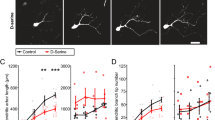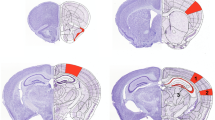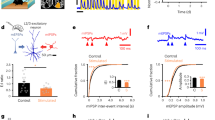Abstract
As first clearly demonstrated by the experiments of Wiesel and Hubel1, the developing visual cortex is exquisitely sensitive to sensory deprivation. Temporary closure of one eye of a kitten during a critical period that extends from 3 weeks to 3 months of age results in a dramatic cortical reorganization such that most neurones, originally binocularly driven, are dominated exclusively by the open eye. Recently, attention has been directed to chemical factors which may influence the degree of plasticity during the critical period. The work of Kasamatsu and Pettigrew2–6 suggests that cortical catecholamines, especially noradrenaline (NA), are essential for the normal plastic response to visual deprivation. In an effort to clarify the role of NA in visual cortical plasticity, we have monocularly deprived kittens whose cortex had been depleted of catecholamines by the neurotoxin 6-hydroxydopamine (6-OHDA)7–9. We used two strategies to deplete cortical NA: the first, pioneered by Kasamatsu et al.5, utilized osmotic minipumps to deliver 6-OHDA to visual cortex; the second involved systemic neonatal injections of 6-OHDA, a technique which has proved effective in rodents10–12. We found, using high-pressure liquid chromatography (HPLC), that both techniques produced a substantial reduction in the level of cortical NA. However, single unit recording in area 17 revealed that the plastic response to monocular deprivation (MD) was only diminished in the kittens depleted by minipump.
This is a preview of subscription content, access via your institution
Access options
Subscribe to this journal
Receive 51 print issues and online access
$199.00 per year
only $3.90 per issue
Buy this article
- Purchase on Springer Link
- Instant access to full article PDF
Prices may be subject to local taxes which are calculated during checkout
Similar content being viewed by others
References
Wiesel, T. N. & Hubel, D. H. J. Neurophysiol. 26, 1003–1017 (1963).
Kasamatsu, T. & Pettigrew, J. D. Science 194, 206–209 (1976).
Pettigrew, J. D. & Kasamatsu, T. Nature 271, 761–763 (1978).
Kasamatsu, T. & Pettigrew, J. D. J. comp. Neurol 185, 139–162 (1979).
Kasamatsu, T., Pettigrew, J. D. & Ary, M., J. comp. Neurol. 185, 163–182 (1979).
Kasamatsu, T., Pettigrew, J. D. & Ary, M. J. Neurophysiol. 45, 254–266 (1981).
Ungerstedt, J. Eur. J. Pharmac. 5, 107–110 (1968).
Bloom, F. E., Algeri, A., Groppetti, A., Revuelta, A. & Costa, E. Science 166, 1284–1286 (1969).
Uretsky, N. J. & Iverson, L. L. J. Neurochem. 17, 269–278 (1970).
Clark, D. W., Laverty, R. & Phelan, E. L. Br. J. Pharmacol. 44, 233–243 (1972).
Sach, C. J. Neurochem. 20, 1753–1760 (1973).
Sachs, C. & Jonsson, G. Brain Res. 99, 277–291 (1975).
Daniels, J. D., Norman, J. L. & Pettigrew, J. D. Expl. Brain Res. 29, 155–172 (1977).
Blasdel, G. G. & Pettigrew, J. D. J. Neuorophysiol. 42, 1692–1710 (1979).
Hubel, D. H. & Wiesel, T. N. J. Physiol., Land. 160, 106–154 (1962).
Anton, A. H. & Sayre, D. F. J. Pharmac. exp. Ther. 138, 360–375 (1962).
Keller, R., Oke, A., Mefford, I. & Adams, R. N. Life Sci. 19, 995–1004 (1976).
Cannon, W. B. & Rosenblueth, A. The Supersensitivity of Denervated Structures (Macmillan, New York, 1949).
Sporn, J. R., Wolfe, B. B., Harden, T. R., Kendell, T. & Molinoff, P. B. Molec. Pharmac. 13, 1170–1180 (1977).
Harik, S. J., Bradford Duckrow, R., LaManna, J. C., Rosenthal, M., Sharma, V. K. & Banerjee, S. P., J. Neurosci. 1, 641–649 (1981).
Author information
Authors and Affiliations
Rights and permissions
About this article
Cite this article
Bear, M., Paradiso, M., Schwartz, M. et al. Two methods of catecholamine depletion in kitten visual cortex yield different effects on plasticity. Nature 302, 245–247 (1983). https://doi.org/10.1038/302245a0
Received:
Accepted:
Issue Date:
DOI: https://doi.org/10.1038/302245a0
This article is cited by
-
A simple quasi-geostrophic coupled ocean-atmosphere model
Advances in Atmospheric Sciences (1991)
-
Modulation of visual cortical plasticity by acetylcholine and noradrenaline
Nature (1986)
Comments
By submitting a comment you agree to abide by our Terms and Community Guidelines. If you find something abusive or that does not comply with our terms or guidelines please flag it as inappropriate.



